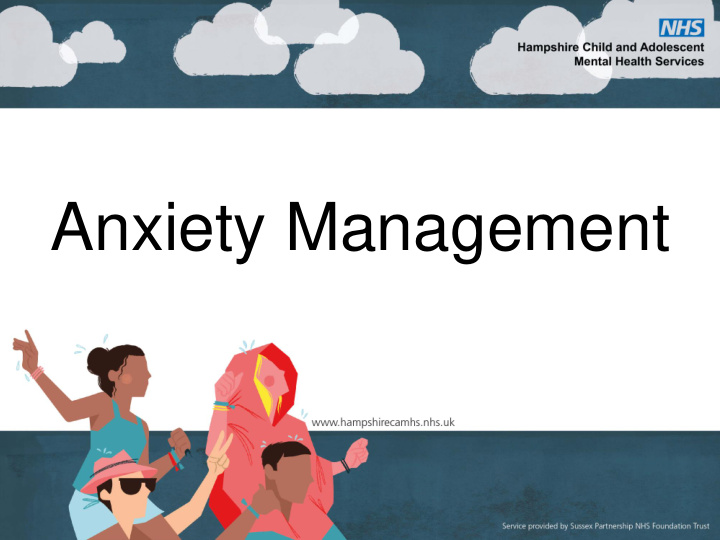



Anxiety Management
• What is anxiety? • Signs and symptoms • Strategies to manage anxiety • Resources
Picking up danger – we’re good at it! • Anxiety has been bred into us over thousands of years as an adaptive survival strategy. In other words: IT’s NORMAL. • Like all mammals our bodies have evolved to always be alert to potential threat. And to communicate distress as the first course of action if safe to. • https://www.youtube.com/watch?v=YemitZJBT1Y
Why do we get anxious?
Our Internal Alarm system
The threat response in human babies • An example of how a baby responds to the threat of losing close attachment behaviour with the mother can be seen in ‘still face experiments’. • https://www.youtube.com/watch?v=apzXGEbZht0
Social context is important • Babies may respond to ‘frightening’ noises coming from parents but learn not to fear it. • How? https://www.youtube.com/watch?v=HX8mIHeuaf0 • Through play and social interaction babies learn how to hold feelings of fear while still discovering, exploring and expanding their experiences and abilities.
Our bodies are on the lookout constantly and alert us to potential incoming threat signals to ‘protect’ us from danger.
Triggers • A social event e.g a party • An upcoming performance e.g exams, school play • Specific phobia, e.g spiders • Going away, separation from parent • Worries about everything and anything: ‘what if…?’
Signs of anxiety Thoughts Physical Feelings Behaviour
When is anxiety a problem? • When it keeps showing up and getting in the way of doing what you need to do e.g going to school, • And doing what you want to do e.g go to a party with your friends.
Why does anxiety keep on showing up? • Problems stick around because how we think, feel and behave MAINTAINS the original anxiety. • We can understand this by looking at the links between our thoughts, feelings and behaviour – what we do.
• HOT CROSS BUN MODEL of ANXIETY Situation : Jess didn’t understand something in Thoughts : Everyone is class and wanted to ask a looking at me, they will question: think I’m stupid, they all know the answer, I’m stupid. BEHAVIOUR : Look down, try to be invisible, not get on with work, escape if FEELINGS : anxiety too much. Physical Anxious, sad Physical sensations : heart racing, breathing shallow, nervous stomach, clammy Vicious cycles hands, go red, hot.
Anyone willing to have a go? Situation: Thoughts: Feelings: Physical sensations : Behaviour: Vicious cycles
What can you do about it?
A.N.D Firstly Aware DESCRIBE the feeling: NAME: the body’s message
Test things out a little at a time
What can you do to support someone with anxiety? • Encouragement and praise for managing difficult situations. • Use rewards for achievement • Provide reflections to develop insight e.g. I wonder if you are feeling worried about the party next week? • Model facing fears or that a situation can be mastered- we know children learn from how others around them respond to situations • Normalise anxiety for them
• Breathing overrides to body’s stress response and brings rational thinking back on line. • Come back to our senses There are many apps and websites with scripts to download- it’s worth trying a few to see which work. Remember not everything will work for everyone
Thinking strategies • Identify the worry / anxious thoughts. • Encourage the young person to question it’s accuracy: is it Fact or fiction? What’s the evidence for and against the thought? • If ‘always’ or ‘never’ are a part of the thought - Are there times when it hasn’t happened? • Think of examples of alternative, rational thoughts. • What would they say to a friend with the same worry? • Aim – create flexibility • Again, there are many resources to help with this.
Young person’s views on managing anxiety • https://www.youtube.com/watch?v=l7g8Atv27Q8
Resources • Websites • www.anxietyBC.com • www.moodjuice.scot.nhs.uk • www.youngminds.org.uk • www.getselfhelp.co.uk • Books • Overcoming your child’s fears and worries – Cathy Creswell and Lucy Willetts (particularly for parents with children under 12 but the strategies could still be useful) • What do to when you worry too much Dawn Huebener
Various APPs • Mindshift • Headspace • Self help for anxiety management (SAM) • Worry Box Please see our leaflets at the CAMHS stand for more details
Recommend
More recommend